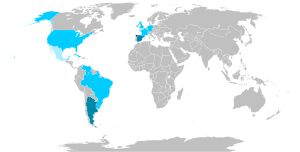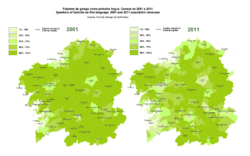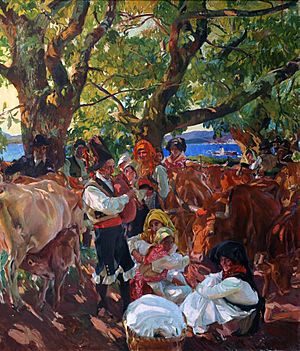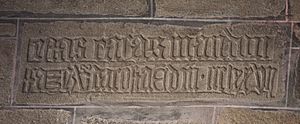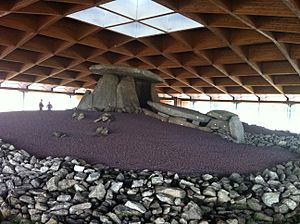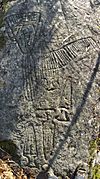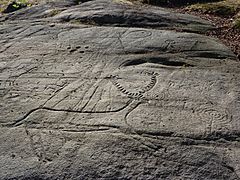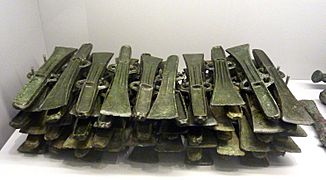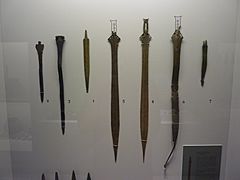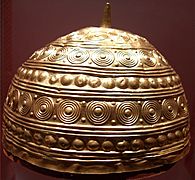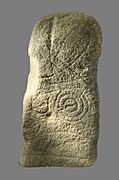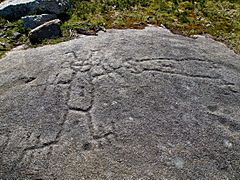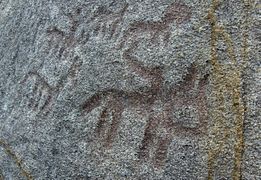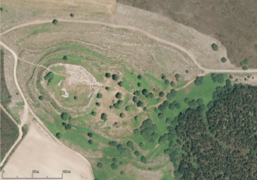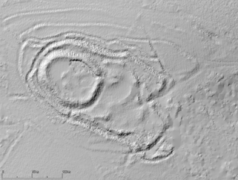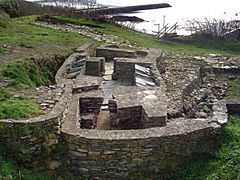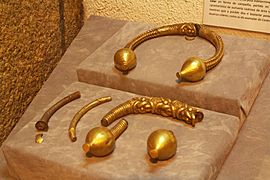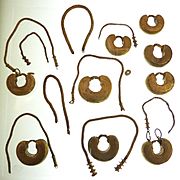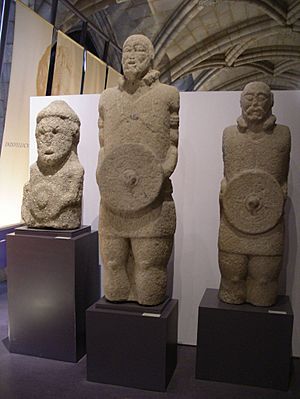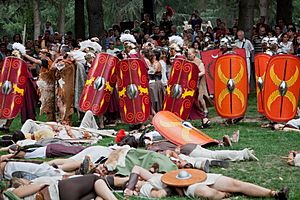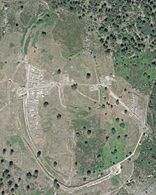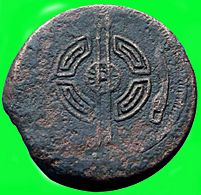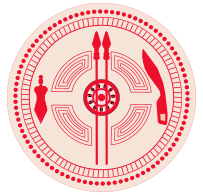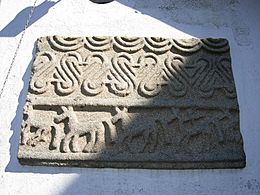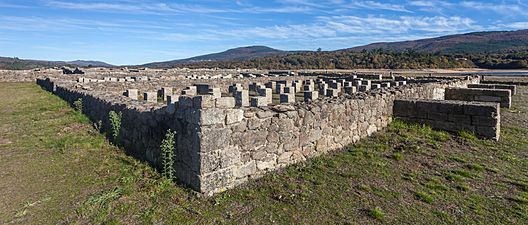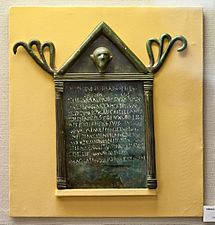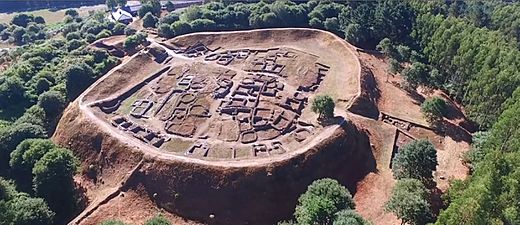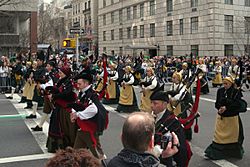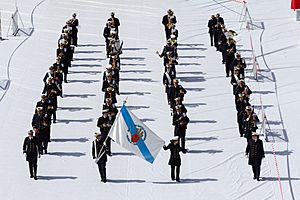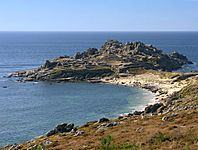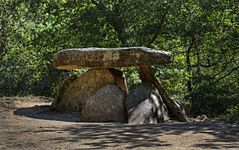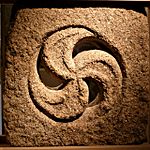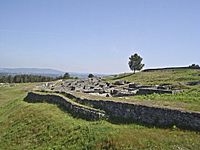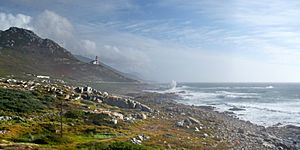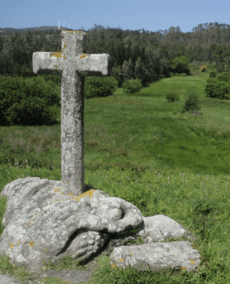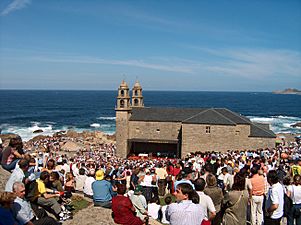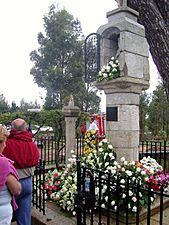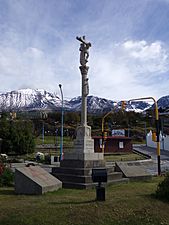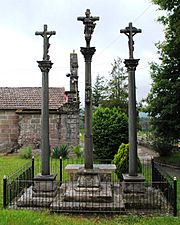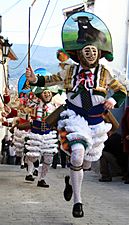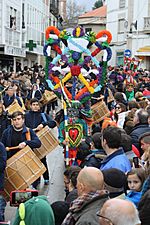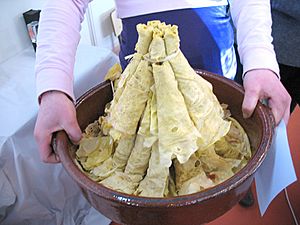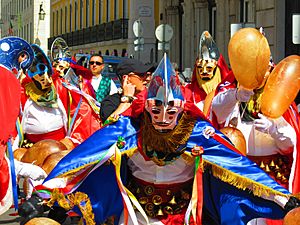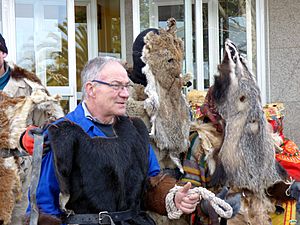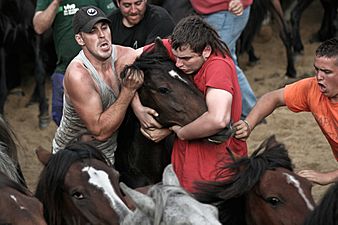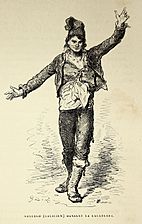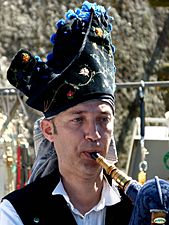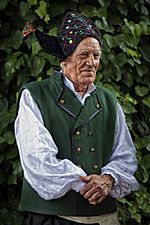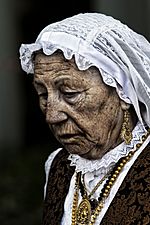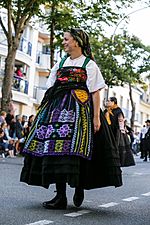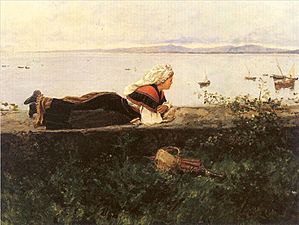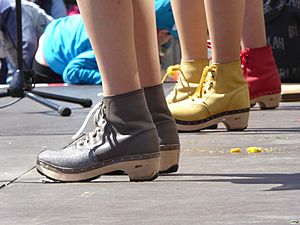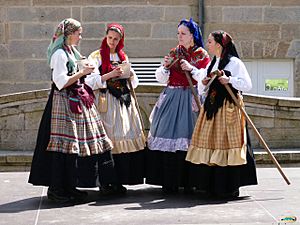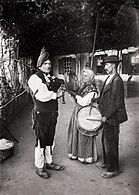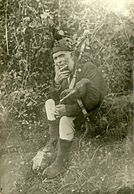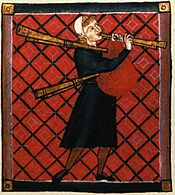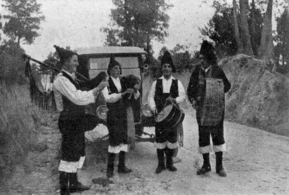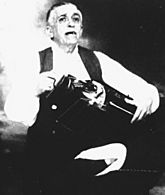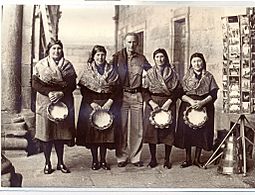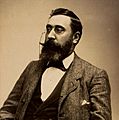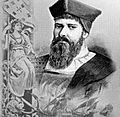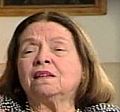Galicians facts for kids

Galician bagpipers
|
|
| Total population | |
|---|---|
| c. 3.2 million | |
| Regions with significant populations | |
| |
|
| |
2,397,613 |
| Province of A Coruña | 991,588 |
| Province of Pontevedra | 833,205 |
| Province of Lugo | 300,419 |
| Province of Ourense | 272,401 |
| 355,063 | |
| 147,062 | |
| 38,440–46,882 | |
| 38,554 | |
| 35,369 | |
| 31,077 | |
| 30,737 | |
| 16,075 | |
| 14,172 | |
| 13,305 | |
| 10,755 | |
| 9,895 | |
| Galicians inscribed in the electoral census and living abroad combined (2013) | 414,650 |
| Languages | |
| Galician, Spanish | |
| Religion | |
| Roman Catholicism, and Protestantism | |
| Related ethnic groups | |
| Portuguese, Asturians, Spaniards, Romance peoples, Celtic peoples. | |
Galicians (galegos in Galician, gallegos in Spanish) are a group of people from Galicia, a region in the northwest of Spain. They are closely related to the Portuguese people. Galicians have a mix of Celtic and Roman heritage. They live on the Iberian Peninsula. Two Romance languages are spoken in Galicia: Galician and Spanish. Both are official languages there.
Contents
What Does "Galician" Mean?
The name "Galicians" (galegos) comes from the Latin word Gallaeci. This name was first used for a local Celtic tribe known to the Greeks as Kallaikoí. These people lived in what is now Galicia and northern Portugal.
The Romans defeated this tribe in the 2nd century BCE. Later, the Romans used the name Gallaeci for all the people in the northwest of the Iberian Peninsula. These people shared a similar culture and language.
Some experts believe the name Callaeci means "the highlanders" (people from the hills). Others think it means "the forest people." Another idea is that it means "the stone people," because of the many ancient stone structures in Galicia and Portugal.
Languages Galicians Speak
The Galician Language
Galician is a Romance language. This means it developed from Latin, just like Spanish and Portuguese. It is an official language in Galicia. People also speak Galician in parts of nearby Asturias and Castile and León.
In the Middle Ages, Galician and Portuguese were one language, called Galician-Portuguese. It was spoken and written in the kingdoms of Galicia and Portugal. This language had a rich tradition of poetry and songs. Over time, it became the language for official documents.
From the 15th century, Galician-Portuguese started to split into two separate languages: Galician and Portuguese. Galician became a regional language, influenced by Castilian Spanish. Portuguese became an international language because of the Portuguese Empire. Even today, the two languages are very similar. Northern Portuguese dialects are especially close to Galician.
The official group that sets rules for the Galician language, the Royal Galician Academy, says that modern Galician is its own language. It belongs to the group of Ibero-Romance languages and is closely related to Portuguese.
However, some groups believe that Galician and Portuguese are still the same language. They think Galician is just one type of Galician-Portuguese, like how there are different types of English.
Today, Galician is officially recognized. But the Spanish language still has a strong influence, especially through media and laws about learning. Despite this, Galicia has a strong oral tradition of songs, stories, and sayings. This has helped the Galician language to spread and grow.
Galician Surnames
Galician surnames often come from a father's name (like Johnson from John), a job, a place, or a nickname. Many common surnames come from fathers' names and became fixed during the Middle Ages. Examples include Fernández, González, and Rodríguez.
Because Galicians settled in southern Spain during the Reconquista (when Christian kingdoms took back land from the Moors), many Galician surnames also became popular in Spanish. They then spread to the Americas with the Spanish Empire.
| English name | Old Galician (13-15th c.) | Modern Galician | Spanish |
|---|---|---|---|
| John | Eanes | Anes, Oanes, Yanes | Yáñez, Ibáñez |
| Stephen | Esteuaes, Esteuaez, Esteueez | Estévez | Estévanez |
| - | Froes, Froez | Fróiz, Frois | Flores, Flórez |
| Julian | Giançe, Gianz, Gians | Giance | Juliánez |
| Ermengild | Meendez, Meendes | Méndez | Menéndez, Meléndez |
| Martin | Martiiz | Martíns, Martís | Martínez |
| Michael | Migueez | Miguéns, Míguez | Miguélez |
| Pelagius | Paaez, Paaz | Páes, Paiz, Paz | Peláez |
| - | Veasques, Vaasquez | Vázquez | Velázquez, Blázquez |
| Benedict | Beeytez, Beeytes | Viéitez, Vieites | Benítez |
Many surnames come from place names. These usually show where a person or their family came from. For example, Dacosta means "of the slope," and Daponte means "of the bridge."
Some surnames are from jobs, like Ferreiro ("Smith") or Carpinteiro ("Carpenter"). Others come from nicknames, describing someone's looks (like Branco for "White" or Delgado for "Slender"), personality, or even animal names.
Over the centuries, many Galician surnames changed to sound more Spanish. This happened especially after the 15th century. For example, Orxás became Orjales. Sometimes, this caused confusion, like Niño da Aguia (Eagle's Nest) becoming Niño de la Guía (the Guide's child).
Galician History
Ancient Times
The first people lived in Galicia during the Stone Age. About 9,300 years ago, a woman lived here. Her genetic study showed she was a mix of different ancient European groups.
Around 6,500 years ago, new people arrived from the Mediterranean. They brought agriculture and raising animals. They cleared forests for farms. These people also built the first permanent structures, like megaliths (large stone monuments). Galicia became an important center for this Megalithic Culture in Atlantic Europe.
About 4,500 years ago, the Bell Beaker people arrived. They brought copper metalworking and new tools. Some experts believe they were the first to bring Indo-European languages to Western Europe. They lived in villages protected by fences. They also buried people in individual stone boxes, showing a shift towards individualism. During this time, many petroglyphs (rock carvings) were made, similar to those found in the British Isles.
- Early Bronze Age
-
The Caldas de Reis hoard, a large collection of ancient treasures.
-
Inside a recreated Bronze Age cabin in Campo Lameiro.
During the Late Bronze Age (until 800-600 BCE), Galicia had more contact with southern Spain and the British Isles. This was likely because of the rich local gold and metals like tin, used to make bronze. People started to hide valuable items, often in water. Large circular structures were also built.
This period is called the Atlantic Bronze Age. Some theories suggest that Celtic languages might have spread from this region.
- Late Bronze Age
-
The Casco de Leiro (Leiro Helmet)
Around 1000-600 BCE, communities started to protect their villages. They built hill-forts (fortified settlements) in safe places. These early forts helped control metal resources and trade. By the 4th century BCE, hill-forts were common throughout Galicia.
These hill-forts had strong walls, ditches, and towers. Inside, houses were first made of wood, then entirely of stone. Some had carved stones and warrior sculptures. Public areas like saunas (probably for rituals) were also found. Gold torcs (necklaces) and other valuable items were common.
This culture is known as the Castro Culture. A unique thing about this culture is that very few burials have been found.
- Iron Age
-
Castromaior, a hill-fort in Portomarín.
From the 6th century BCE, there was more trade with Mediterranean sailors. Punic (from ancient Carthage) goods became common in southern Galicia. In return, the Punics got tin and gold.
Roman Conquest and Rule
The first time Romans met Galicians was during the Second Punic War. Galicians and other groups fought as hired soldiers for Hannibal against Rome. An ancient poem describes Galician warriors singing and clashing their shields. It also says Galician women did most of the farming while men focused on war.
In 138 BCE, the Roman general Decimus Junius Brutus Callaicus led a successful campaign into Galicia. He conquered many places. He was given the name Callaicus for his victory. A large Roman camp from this time was found near the border with Portugal.
Roman contact greatly changed the Castro Culture. Trade increased, and people started making more sculptures and stone carvings. Some hill-forts grew into large towns called oppida, with streets and public areas.
- Oppida and Roman conquest
-
Santa Trega with the Minho River in the background.
In 61 BCE, Julius Caesar led a naval campaign along the Atlantic coast, reaching Brigantium. The locals, who had never seen a Roman fleet, were amazed and surrendered. Finally, in 29 BCE, Augustus launched a major campaign to conquer the Galicians and other groups. Many Roman camps from this war have been found in Galicia. Augustus's victory is celebrated on monuments in Turkey and France.
After the Roman conquest, Galicia was divided into three areas and became part of the Roman province of Hispania Tarraconensis. Roman legions were stationed nearby, and local Galicians were recruited into the Roman army.
Galicia and Asturias became very important for gold production in the Roman Empire. Roman gold mines in Galicia produced huge amounts of gold.
-
Reenactors at Lugo's Arde Lucus festival.
Romanization and Medieval Eras
Galicia was Romanized later and less strongly than other parts of Spain. However, Latin eventually replaced the old native languages, like Gallaecian Celtic.
After the Roman Empire declined, Germanic tribes took over. The Suebi formed a separate Galician kingdom in 409 CE. Later, the Visigoths ruled. In 718 CE, the Moors briefly controlled the area after conquering the Visigothic Empire. But Galicians successfully rebelled in 739 CE. This led to a new Kingdom of Galicia, which became stable after 813 CE with the popularity of the "Way of St James" pilgrimage route.
Geography and People
Provinces and Cities
Galicia is an autonomous community in Spain. It has four provinces: A Coruña, Lugo, Ourense, and Pontevedra.
The main cities are Vigo (in Pontevedra), Pontevedra, Santiago de Compostela, A Coruña, Ferrol (in A Coruña), Lugo (in Lugo), and Ourense (in Ourense).
Population and Languages
In 2008, Galicia had about 2.78 million people. The official languages are Galician and Spanish. Almost everyone knows Spanish. After a period of decline, the number of Galician speakers is growing again. About 82% of Galicians can speak the language, and about 61% learned it as their first language.
Galician Culture
Celtic Identity and Revival
In the 19th century, writers and scholars started a Celtic revival in Galicia. They based this on old Roman and Greek writings that mentioned Celtic peoples in Galicia. They also found similarities in language, place names, and culture between Galicia and other Celtic countries like Ireland and Brittany. These similarities included legends, traditions, art, and music. The green, hilly landscape and many ancient hill-forts and stone structures also made people feel a connection to Celtic heritage.
This Celtic revival became a big part of Galician identity. In 1916, a poem called Os Pinos became the lyrics for the Galician anthem. It talks about Galicians being "sons of the noble Celts." Many cultural groups and sports clubs, like Celta de Vigo, were named after the Celts.
Since the 1970s, Celtic music and cultural festivals have become popular. The Festival Internacional do Mundo Celta de Ortigueira is a famous example. Galician folk bands also perform at Celtic festivals around the world.
- Elements often seen as Celtic in Galicia.
-
A medieval interlaced cross in Santiago de Compostela.
-
A Triskelion from the Museo de Ourense.
-
Galician Neolithic or Bronze Age cup and ring marks.
Folklore and Traditions
Galician folklore is similar to that of other parts of western Europe, especially northern Portugal. Here are some popular myths and legends:
- Talking Animals: Many old stories begin with "back then, when animals used to speak," like "once upon a time" in English.
- Mouros: These are ancient, dark beings who lived in the world before humans. They are often found near old ruins like barrows and dolmens. People believe they can travel between their underworld and our world.
- Fairies and Nymphs: Called mouras, encantos, or damas, these beautiful, rich women are often found near ancient ruins or fountains, combing their long golden hair. Some are giant women with incredible strength.
- Lavandeiras: These are eerie washerwomen found at rivers, especially at night. If you help them twist clothes the wrong way, the clothes turn into blood.
- Trasnos: These are mischievous goblins or household creatures. They like to annoy people, cause nightmares, and move things around.
- Golden Hen: A golden hen followed by golden chicks appears, but can never be caught.
- Maruxaina: A mean siren who lived near San Cribrao. She was eventually caught and executed by the locals.
- Nubeiros: Beings who control the weather, especially clouds.
- Drowned Cities: Many lakes are believed to cover ancient cities that sank because their people were unkind or a powerful being used magic. Sometimes, the city's bells can still be heard at night.
- Bellowing Ox: A mythical ox that bellows at night near lakes.
- Olláparos: Giants similar to cyclopes, sometimes with an eye on the back of their head.
- Bruxas and Meigas: Witches who can turn into animals. Chuchonas are witches who turn into blowflies to feed on babies' blood.
- Lobishomes: Werewolves are humans who turn into wolves because of a curse.
- Serpents and Dragons: Ancient stories tell of giant serpents and dragons. One legend says Saint James's disciples faced a dragon on Pico Sagro.
- Santa Compaña: This is a ghostly procession of the dead, like a wild hunt. They carry candles and announce when someone nearby will die. They can force a living person to join them. You can protect yourself by drawing a circle on the ground and stepping inside it.
Traditions and Beliefs
Galician society has been strongly Catholic. However, many old beliefs from earlier times still exist. These include beliefs in gods (now seen as saints), reincarnation, the evil eye, and the sacredness of crossroads and fountains.
- Sanctuaries: These are important places for pilgrimages (romaría). Each is protected by a saint or Virgin Mary. For example, at Santo André de Teixido, people say, "to Saint Andrew at Teixido goes as dead the ones that didn't went while alive," meaning you must visit it at some point. Many sanctuaries were likely built over older pagan worship sites.
- Cruceiros: These are stone crosses or monuments, often found at crossroads, near sacred places, or along pilgrimage routes. People often place flowers or lit candles in front of them.
- Sanctuaries, ''cruceiros'' and ''petos de ánimas''
-
Virxe da Barca, Muxía.
-
Santo André de Teixido, Cedeira.
-
A cruceiro at Muros.
- Traditional Medicine: Menciñeiros (healers) used herbs and spells to treat illnesses. Compoñedores specialized in mending bones.
Popular Feasts
Besides Catholic holidays, Galicians celebrate other annual events with ancient roots:
- Entroido (Carnival): This is a time of celebration and feasting before the serious period of Holy Week. Parades and festivals are held throughout Galicia. In Ourense, people wear special masks like peliqueiros and cigarróns, who might play small tricks on others.
- Noite de San Xoán (Saint John's Eve): Celebrated around bonfires at dusk. Young people jump over the fire. Other traditions include bathing in the ocean and preparing "Saint John's water" with herbs.
- Rapa das Bestas: This is a traditional event where wild horses are rounded up, marked, and their manes and tails are trimmed.
- Feasts
-
Carantoñas from Chantada.
Traditional Costume
Galician traditional clothing became popular in the late 18th century. Some parts, like the monteira (an embroidered felt hat), have been around since the 16th century.
Men's clothing usually includes a monteira, shirt, vest, jacket, sash, breeches, underwear, gaiters, and clogs or boots.
- Men's traditional costume
Women's clothing includes a coif or headcloth, a short cape or bodice, a shirt, petticoat, skirt, apron, and a pouch or bag.
- Women's traditional costume
-
Galician woman by Serafín Avendaño, 1891.
Traditional Music
The most famous instrument in Galician traditional music is the gaita (bagpipe). The gaita has a conical chanter and usually one to four drones. It can be played by blowing into a pipe or using bellows. In the past, the gaita was often played with just a snare drum and bass drum. Today, full bands are very popular.
Common types of music played with the gaita include the muiñeira, a lively dance tune similar to an Irish jig. The alborada is played in the early mornings of holidays. The marcha (march) accompanies processions.
Another important instrument is the pandeireta (tambourine). It is often played with other drums and castanets to accompany songs and celebrations.
Other music styles include the alalá, which can be sung without instruments, and cancións de cego (blindman's songs), played with a violin or zanfoña.
- Galician music and dancers
-
A bagpiper from the 13th century, shown in the Cantigas de Santa Maria.
Literature
-
Rosalía de Castro was a key author in the revival of the Galician language.
-
Eduardo Pondal imagined a free Celtic past for Galicia.
-
Manuel Curros Enríquez was a Galician writer known for his support of republicanism.
Painting, Plastic Arts, and Architecture
-
Architect Antonio Palacios.
Science
-
Benito Jerónimo Feijóo y Montenegro was a monk and scholar who wrote many essays on science and other subjects.
-
Martin Sarmiento wrote on a wide range of topics, including literature, medicine, and linguistics.
Music
-
Carlos Núñez is a famous Galician bagpiper who has worked with many international artists.
Sport
-
Óscar Pereiro is a professional road bicycle racer who won the 2006 Tour de France.
-
Ana Peleteiro is a triple jumper and national record holder.
Cinema and TV
-
Oliver Laxe is a French-born Galician director whose film Fire Will Come was very successful.
-
Maria Casarès was a distinguished star of French stage and cinema.
Famous People of Galician Origin
-
Cuban former leader Fidel Castro.
-
Francisco Franco, former leader of Spain.
-
Portuguese explorer João da Nova.
-
American actor Martin Sheen, born Ramón Estévez.
-
Brazilian writer Nélida Piñon.
-
Argentinian ex-president Raúl Alfonsín.
-
Laurentino Cortizo Cohen, president of Panama.
-
Tabaré Vázquez, ex-president of Uruguay.
-
Mariano Rajoy, former Prime Minister of Spain.
-
Santiago Casares Quiroga, former Prime Minister of Spain.
Images for kids
See Also
- List of Galician people
- Galician nationalism
- Fillos de Galicia
- Spanish people
- Nationalities and regions of Spain


